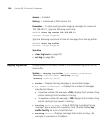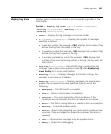
504 CHAPTER 20: SYSTEM LOG COMMANDS
Defaults — None.
Access — Enabled.
History — Introduced in MSS Version 3.0.
Examples — Type the following command to see the facilities for which
you can view event messages archived in the buffer:
WX4400# display log trace facility ?
<facility name> Select one of: KERNEL, AAA, SYSLOGD, ACL, APM, ARP,
ASO, BOOT, CLI, CLUSTER, COPP, CRYPTO, DOT1X, ENCAP, ETHERNET, GATEWAY, HTTPD,
IGMP, IP, MISC, NOSE, NP, RAND, RESOLV, RIB, ROAM, ROGUE, SM, SNMPD, SPAN, STORE,
SYS, TAGMGR, TBRIDGE, TCPSSL, TELNET, TFTP, TLS, TUNNEL, VLAN, X509, XML, MAP,
RAPDA, WEBVIEW, EAP, PORTCONFIG, FP.
See Also
clear log on page 499
display log config on page 502
set log Enables or disables logging of WX and MAP events to the WX log buffer
or other logging destination and sets the level of the events logged. For
logging to a syslog server only, you can also set the facility logged.
Syntax —
set log {buffer | console | current | server ip-addr
| sessions
| trace} [severity severity-level] enable | disable]
Syntax — set log server ip-addr [severity severity-level
[local-facility facility-level]] [enable | disable]
buffer — Sets log parameters for the log buffer in nonvolatile
storage.
console — Sets log parameters for console sessions.
current — Sets log parameters for the current Telnet or console
session. These settings are not stored in nonvolatile memory.
server ip-addr — Sets log parameters for a syslog server. Specify an
address in dotted decimal notation.
sessions — Sets the default log values for Telnet sessions. You can
set defaults for the following log parameters:
Severity


















